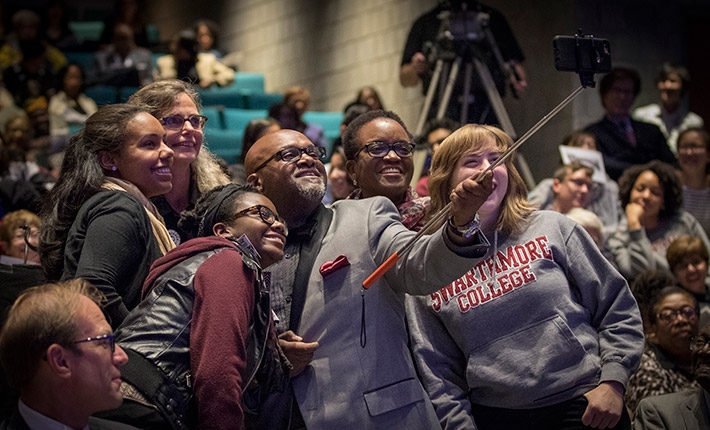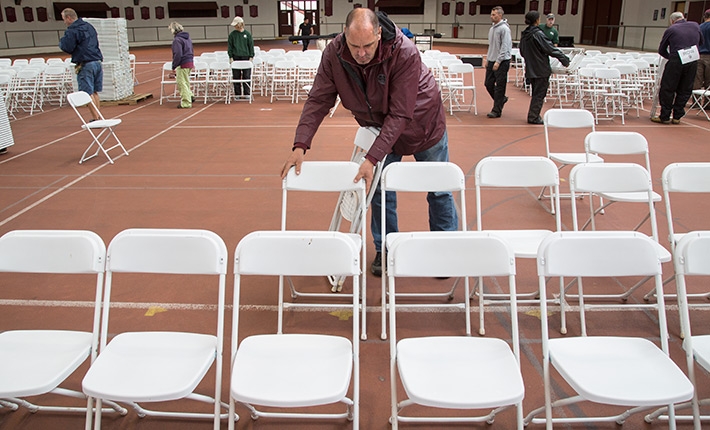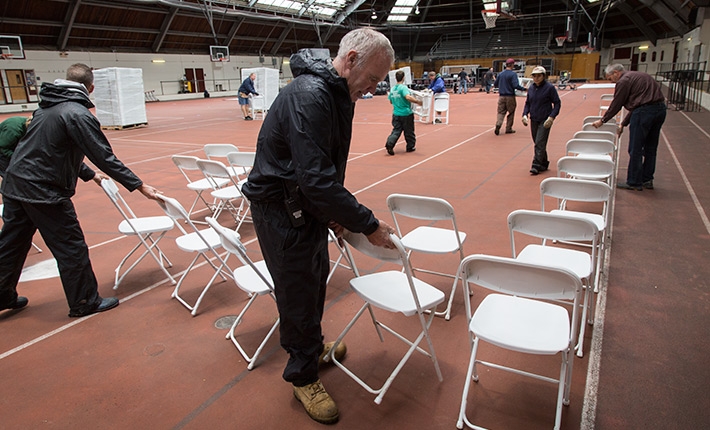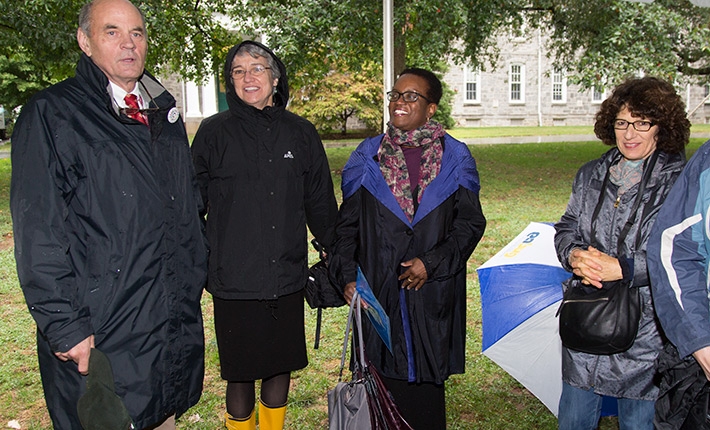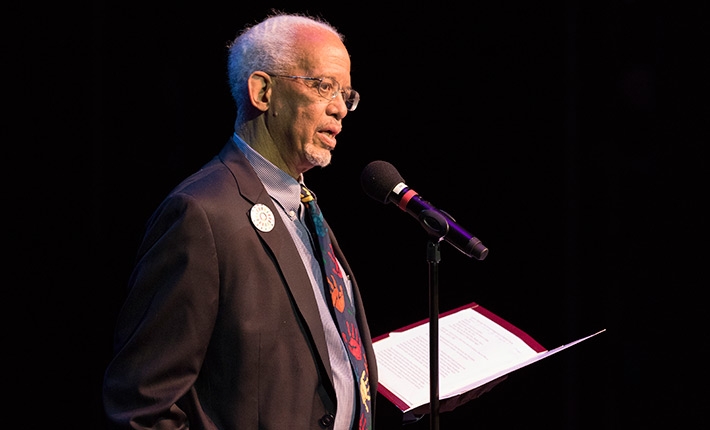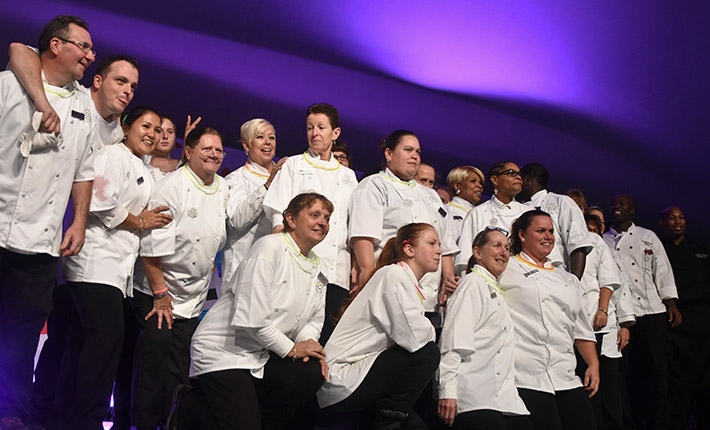‘All Hands on Deck’: Planning the Inauguration
Still delighting in the announcement of Valerie Smith as Swarthmore’s 15th president, the College community turned its attention to planning the inauguration. There was only one problem.
“Most of us had no experience with running an inauguration,” says Kathy Siwicki, co-chair of the inauguration steering committee and professor of neurobiology. “But we were all so excited that we just said, ‘OK — we’ll figure it out as we go along.’”
Thanks to the unparalleled level of collaboration from all corners of the College, they did just that, setting the stage for an event that captivated more than 1,200 members of the community while showcasing the dynamism of the College.
- 81: Colleges and universities represented in the procession
- 2,727: Longest distance in miles traveled by a procession delegate
- 14: Number of Swarthmore faculty and staff members serving as institutional representatives
Think commencement in Technicolor. From the pizzazz of the performing arts events to the rich perspectives of the symposium to the pomp of the installation ceremony, vitality pervaded.
“Swarthmore is great at throwing a party,” says Syd Carpenter, a steering committee member and professor of studio art, “but this one was the most spectacular of my many years at the College.”
It was a party a long time in the planning. From late spring until the eve of the event, five working groups geared to specific aspects of the inauguration joined the steering committee in fleshing out the weekend. Their mission, aligning with the wishes of the woman of the hour: a grand celebration of not just President Smith but the splendor of Swarthmore itself.
Enthusiasm abounded from meeting one. At times, there were too many good ideas, and participants needed to zero in on the fundamentals.
“For that we kept coming back to Val’s vision,” says Susan Eagar, steering committee member and events manager for development and alumni relations, whose purview included the grand tent in which Saturday’s lunch and campus celebration, rich with student performances, were held.
- 11: Current college and university presidents in attendance
- 3: Former Swarthmore presidents in attendance
- 1: Oak tree planted in front of Parrish Hall to mark the occasion
The brass tacks, then: How do we feed, inspire, entertain, accommodate, and assure the comfort of upwards of 2,000 people?
“I called all hands on deck,” says Linda McDougall, logistics committee member and Dining Services director, who carefully planned with her team the storing, preparing, and serving of more than twice as many meals as a normal weekend with the same amount of staff.
“It was exciting, though,” she says. “This was a platform to show what we can do.”
“It’s an extra level of responsibility, but also extra excitement,” adds Brian Vazquez, manager of environmental services, which had to work overtime to transition spaces between events and keep campus tidy. “We were excited to be a part of history.”
There were the logistics of locating, setting up, and supporting all of the events, says Stu Hain, steering committee member and vice president for facilities and capital projects. Shuttles, golf carts, tents, lights, tables and chairs, sound systems, portable restrooms. Media Services, Public Safety, Grounds and Horticulture — oh my.
“There were a lot of stirrers in this soup,” says Hain.
The performing arts working group had the task, at once delightful and daunting, of selecting the right mix of students, staff, faculty members, and alumni to convey the community's excitement for President Smith.
- 9: Symposium moderators and panelists
- 53: Members of the inauguration steering committee and various working groups
- 1347: RSVPs received and counted
"It was exciting to tap into the array of talented performers from our community, whether it was dance, music, or spoken word,” says Carpenter. “A wonderful array.”
There was no shortage of options for the symposium working group, either, given the theme of inauguration: Changing Lives, Changing the World.
“It became clear to us that there are dozens, maybe hundreds, maybe thousands of our alumni out in the world doing that every day,” says Siwicki.
Once the inauguration theme was selected, Phillip Stern ’84, associate director for design, communications, met with President Smith and working groups to translate it into a logo.
“Those discussions were the key,” he says, “and I think the final product captures the sense of energy, community, and dynamism that has been in the air at Swarthmore and that Val is bringing out."
The communications working group also handled the development of a website and the design and creation of programs, invitations, banners, and signs; increased awareness of the events through traditional and social media; and managed photography, video, and, with help from Media Services, the livestreaming of the events so that community members could watch from afar.
- 4000: Meals prepared on campus for Saturday
- 1500: Chairs arranged by Facilities Services in the Field House
- 2200: programs printed
-
3: Densely packed truckloads of plants curated for the symposium and installation ceremony by Scott Arboretum staff
"After months of planning a countless number of details, everything came together seamlessly," says Director of Communications Alisa Giardinelli. "From all of the social media outreach, two day's worth of recordings, and the livestream in particular, it's perhaps the most complex team effort we've attempted."
Planning for the installation procession and ceremony was a complicated dance as well. The working group fostered the participation of 84 delegates from colleges and universities as nearby as the Tri-Co partners and as far as UCLA. That list was still coming together until late in the game, however, at which point it was difficult to line up Swarthmore faculty hosts for each of the delegates, says steering committee member and faculty marshall Paul Rablen. Still, when the procession began to the sounds of the Gamelan Semara Santi orchestra, it looked smooth and stately.
Behind the curtain of the performances and the symposia was the Lang Performing Arts Center (LPAC) production staff, which was responsible for how they looked, sounded, and flowed. On Friday night, they transitioned the staging from a choir to a dance piece to a piano duet to a chamber orchestra to a jazz ensemble to a bare stage with a single drum — all while trying to stay faithful to the performers with whom they had scant rehearsal time.
“It’s a tussle,” says James Murphy, managing director. “Preparation and cooperation were key, but we were also prepared to make some adjustments on the fly.”
The ultimate adjustment, though, came as a result of Mother Nature. Rains battered campus on the eve of the weekend, moving the tree planting (commemorating an 1869 planting by Swarthmore's founders) and collection under a tent and the installation procession and ceremony from the Scott Outdoor Amphitheater into the Lamb-Miller Field House. They did not, however, dampen the spirits of the community or catch the logistics working group off guard.
“One of the first calls I made [in the process] was to secure the equipment needed to turn the field house into a performance venue,” says LPAC production manager Tom Snyder. “We had been working both scenarios all along to ensure that, rain or shine, the event went off without a hitch.”
- 30: Arts performances and readings throughout the weekend
- 700: Gigabytes of data recorded over the weekend
- 7: Countries where people watched the livestream of the ceremony. In addition to the U.S., they are Algeria, Colombia, Ghana, Ireland, Israel, and the United Kingdom.
- 68: Photos shared on Instagram using #ValSmith15
Communication was central to that effort, he says, whether it was a large committee meeting, a conference call, or an e-mail chain. Although the process was arduous at times, and coming on top of everyone’s normal work loads, it also gave community members a different perspective of one another’s contributions.
“We all interact on a pretty regular basis with folks working hard every day to keep this place together,” says Siwkicki. “But to see all the moving parts required to bring together an event of this magnitude, from this perspective, has just been incredibly eye opening.”
Zenobia Hargust, steering committee co-chair and director, equal opportunity and engagement, human resources, notes that the planning followed concerted dialogue on campus last year about what it takes to build community.
“It was so wonderful to see so many facets of the College pull together to make this event a success,” she says, “and a true testament to our commitment to community here.”
When the steering committee met for the last time in late September, there were a lot of arrangements yet to be made and details to be wrangled. But Lydia Koku ’18, a steering committee member from Cherry Hill, N.J., took a moment to reflect on the experience.
“‘This is it,’ I thought to myself,” she says. “I remembered how about four months ago, none of our plans existed, and many of us were strangers. It was surreal, it is surreal, to consider how much changed since May. I’m glad that collectively, as a committee and as a community, we can own this event and reflect on what it took to get here.”
